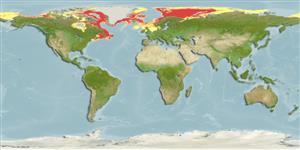Environment: milieu / climate zone / depth range / distribution range
ນິເວດວິທະຍາ
ສັດທະເລ ອາໄສຢູ່ໃກ້ໜ້າດິນໃຕ້ພື້ນທ້ອງນ້ຳ; ລະດັບຄວາມເລິກ 25 - 1187 m (Ref. 58426). Polar; 84°N - 42°N, 180°W - 180°E
Arctic: Arctic Alaska, Smith Sound, northwest Greenland, Kara Sea, Barents Sea, off Spitsbergen, coast of Norway, Wyville-Thomson Ridge, Iceland, northeast Greenland, and localities off western Greenland.
ຂະໜາດ / ນ້ຳໜັກ / Age
Maturity: Lm ? range ? - ? cm
Max length : 44.5 cm SL ຕົວຜູ້/ບໍ່ມີເພດ; (Ref. 11976)
Benthic; feeds on crustaceans (Ref. 58426). Switches feeding habits with increasing size. Smaller eelpouts eat mainly endobenthic prey, larger individuals feed more on epibenthic prey (Ref. 13532).
Life cycle and mating behavior
Maturities | ການສືບພັນ | Spawnings | Egg(s) | Fecundities | ຕົວອ່ອນ
McAllister, D.E., M.E. Anderson and J.G. Hunter, 1981. Deep-water eelpouts, Zoarcidae, from Arctic Canada and Alaska. Can. J. Fish. Aquat. Sci. 38(7):821-839. (Ref. 11976)
IUCN Red List Status (Ref. 130435)
Threat to humans
Harmless
Human uses
ເຄື່ອງມື
Special reports
Download XML
ແຫຼ່ງອີນເຕີເນັດ
Estimates based on models
Preferred temperature (Ref.
123201): -0.9 - 4, mean 0.8 °C (based on 1789 cells).
Phylogenetic diversity index (Ref.
82804): PD
50 = 0.5000 [Uniqueness, from 0.5 = low to 2.0 = high].
Bayesian length-weight: a=0.00251 (0.00156 - 0.00403), b=3.21 (3.07 - 3.35), in cm total length, based on LWR estimates for this species & Genus-body shape (Ref.
93245).
ຊັ້ນເຂດຮ້ອນ (Ref.
69278): 3.5 ±0.50 se; based on food items.
ຄວາມຢືດຢຸ່ນ (Ref.
120179): ຕຳ່ຫຼາຍ, ປະຊາກອນຕຳ່ສຸດທີ່ໃຊ້ເວລາສອງເທົ່າຫຼາຍກວ່າ 14 ປີ (Preliminary K or Fecundity.).
Fishing Vulnerability (Ref.
59153): Moderate vulnerability (42 of 100).
